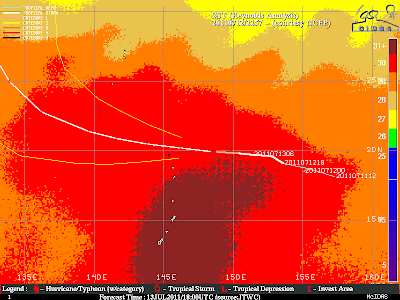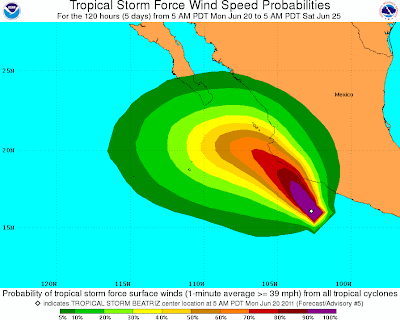This is a continuation from my previous blog on Charge Generation in Thunderstorms.
As electrical charges are separated in a cloud, the electric field intensity increases and eventually exceeds that which the air can sustain. The resulting dielectric breakdown assumes the form of a lightning flash that can be either (1) within the cloud itself, between clouds, or from the cloud to the air (which we will call cloud flashes) or (2) between the cloud and the ground (a ground flash).
As electrical charges are separated in a cloud, the electric field intensity increases and eventually exceeds that which the air can sustain. The resulting dielectric breakdown assumes the form of a lightning flash that can be either (1) within the cloud itself, between clouds, or from the cloud to the air (which we will call cloud flashes) or (2) between the cloud and the ground (a ground flash).
Ground flashes that charge the ground negatively originate from the lower main negative charge center in the form of a discharge, called the stepped leader, which moves downward toward the Earth in discrete steps. Each step lasts for about 1 µs, during which time the stepped leader advances about 50 m; the time interval between steps is about 50 µs. It is believed that the stepped leader is initiated by a local discharge between the small pocket of positive charge at the base of a thundercloud and the lower part of the negatively charged region (see image below). This discharge releases electrons that were previously attached to precipitation particles in the negatively charged region. These free electrons neutralize the small pocket of positive charge that may be present below the main charging zone and then move toward the ground. As the negatively charged stepped leader approaches the ground, it induces positive charges on the ground, especially on protruding objects, and when it is 10-100 m from the ground, a discharge moves up from the ground to meet it. After contact is made between the stepped leader and the upward connecting discharge, large numbers of electrons flow to the ground and a highly luminous and visible lightning stroke propagates upward in a continuous fashion from the ground to the cloud along the path followed by the stepped leader. This flow of electrons (called the return stroke) is responsible for the bright channel of light that is observed as a lightning stroke. Because the stroke moves upward so quickly (in about 100 µs), the whole return stroke channel appears to the eye to brighten simultaneously.
Lightning Flash Animation. (Stepped Leader, Return Stroke, and Dart Leader)
After the downward flow of electrons, both the return stroke and the ground, to which it is linked, remain positively charged in response to the remainder of the negative charge in the main charging zone. Following the first stroke, which typically carries the largest current (average 30,000 A), subsequent strokes can occur along the same main channel, provided that additional electrons are supplied to the top of the previous stroke within about 0.1 s of the cessation of current. The additional electrons are supplied to the channel by so-called K or J streamers, which connect the top of the previous stroke to progressively more distant regions of the negatively charged area of the cloud . A negatively charged leader, called the dart leader, then moves continuously downward to the Earth along the main path of the first-stroke channel and deposits further electrons on the ground. The dart leader is followed by another visible return stroke to the cloud. The first stroke of a flash generally has many downward- directed branches because the stepped leader is strongly branched; subsequent strokes usually show no branching, because they follow only the main channel of the first stroke. Most lightning flashes contain three or four strokes, separated in time by about 50 ms, which can remove 20 coulomb or more of charge from the lower region of a thundercloud. The charge-generating mechanisms within the cloud must then refurbish the charge before another stroke can occur. This they can do in as little as 10 s.
In contrast to the lightning flashes described earlier, most flashes to mountain tops and tall buildings are initiated by stepped leaders that start near the top of the building, move upward, and branch toward the base of a cloud. Lightning rods protect tall structures from damage by routing the strokes to the ground through the rod and down conductors rather than through the structure itself.
(a) (b)
(a) A time exposure of a ground lightning flash that was initiated by a stepped leader that propagated from the cloud to the ground. Note the downward-directed branches that were produced by the branched stepped leader.(b) A time exposure of a lightning flash from a tower on a mountain to a cloud above the tower. This flash was initiated by a stepped leader that started from the tower and propagated upward to the cloud. In contrast to (a), note the upward-directed branching in (b).
A lightning discharge within a cloud generally neutralizes the main positive and negative charge centers. Instead of consisting of several discrete strokes, such a discharge generally consists of a single, slowly moving spark or leader that travels between the positively and the negatively charged regions in a few tenths of a second. This current produces a low but continuous luminosity in the cloud upon which may be superimposed several brighter pulses, each lasting about 1 ms. Tropical thunderstorms produce about 10 cloud discharges for every ground discharge, but in temperate latitudes the frequencies of the two types of discharge are similar. The return stroke of a lightning flash raises the temperature of the channel of air through which it passes to above 30,000 K in such a short time that the air has no time to expand. Therefore, the pressure in the channel increases almost instantaneously to 10-100 atm. The high-pressure channel then expands rapidly into the surrounding air and creates a very powerful shock wave (which travels faster than the speed of sound) and, farther out, a sound wave that is heard as thunder. Thunder is also produced by stepped and dart leaders, but it is much weaker than that from return strokes. Thunder generally cannot be heard more than 25 km from a lightning discharge. At greater distances the thunder passes over an observer’s head because it is generally refracted upward due to the decrease of temperature with height.
Although most ground lightning flashes carry negative charge to the ground, about 10% of the lightning flashes in mid-latitude thunderstorms carry a positive charge to the ground. Moreover, these flashes carry the largest peak currents and charge transfers. Such flashes may originate from the horizontal displacement by wind shear of positive charge in the upper regions of a thunderstorm or, in some cases, from the main charge centers in a thunderstorm being inverted from normal.



































